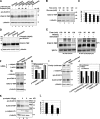Nuclear translocation of an ICA512 cytosolic fragment couples granule exocytosis and insulin expression in {beta}-cells
- PMID: 15596545
- PMCID: PMC2172607
- DOI: 10.1083/jcb.200408172
Nuclear translocation of an ICA512 cytosolic fragment couples granule exocytosis and insulin expression in {beta}-cells
Abstract
Islet cell autoantigen 512 (ICA512)/IA-2 is a receptor tyrosine phosphatase-like protein associated with the insulin secretory granules (SGs) of pancreatic beta-cells. Here, we show that exocytosis of SGs and insertion of ICA512 in the plasma membrane promotes the Ca(2+)-dependent cleavage of ICA512 cytoplasmic domain by mu-calpain. This cleavage occurs at the plasma membrane and generates an ICA512 cytosolic fragment that is targeted to the nucleus, where it binds the E3-SUMO ligase protein inhibitor of activated signal transducer and activator of transcription-y (PIASy) and up-regulates insulin expression. Accordingly, this novel pathway directly links regulated exocytosis of SGs and control of gene expression in beta-cells, whose impaired insulin production and secretion causes diabetes.
Figures







Similar articles
-
Dephosphorylation of beta2-syntrophin and Ca2+/mu-calpain-mediated cleavage of ICA512 upon stimulation of insulin secretion.EMBO J. 2001 Aug 1;20(15):4013-23. doi: 10.1093/emboj/20.15.4013. EMBO J. 2001. PMID: 11483505 Free PMC article.
-
Synergy of glucose and growth hormone signalling in islet cells through ICA512 and STAT5.Nat Cell Biol. 2006 May;8(5):435-45. doi: 10.1038/ncb1395. Epub 2006 Apr 16. Nat Cell Biol. 2006. PMID: 16622421
-
Post-translational modifications of ICA512, a receptor tyrosine phosphatase-like protein of secretory granules.Eur J Neurosci. 1999 Aug;11(8):2609-20. doi: 10.1046/j.1460-9568.1999.00677.x. Eur J Neurosci. 1999. PMID: 10457160
-
[Cytological bases of insulin formation and secretion in the pancreatic beta cells].Probl Endokrinol (Mosk). 1980 Jan-Feb;26(1):72-9. Probl Endokrinol (Mosk). 1980. PMID: 6987645 Review. Russian. No abstract available.
-
Glucose-stimulated signaling pathways in biphasic insulin secretion.Diabetes Metab Res Rev. 2002 Nov-Dec;18(6):451-63. doi: 10.1002/dmrr.329. Diabetes Metab Res Rev. 2002. PMID: 12469359 Review.
Cited by
-
Loss of the transcriptional repressor PAG-3/Gfi-1 results in enhanced neurosecretion that is dependent on the dense-core vesicle membrane protein IDA-1/IA-2.PLoS Genet. 2009 Apr;5(4):e1000447. doi: 10.1371/journal.pgen.1000447. Epub 2009 Apr 3. PLoS Genet. 2009. PMID: 19343207 Free PMC article.
-
Calpain-generated natural protein fragments as short-lived substrates of the N-end rule pathway.Proc Natl Acad Sci U S A. 2014 Mar 4;111(9):E817-26. doi: 10.1073/pnas.1401639111. Epub 2014 Feb 18. Proc Natl Acad Sci U S A. 2014. PMID: 24550490 Free PMC article.
-
Signaling from the secretory granule to the nucleus.Crit Rev Biochem Mol Biol. 2012 Jul-Aug;47(4):391-406. doi: 10.3109/10409238.2012.694845. Epub 2012 Jun 8. Crit Rev Biochem Mol Biol. 2012. PMID: 22681236 Free PMC article. Review.
-
Widespread dysregulation of peptide hormone release in mice lacking adaptor protein AP-3.PLoS Genet. 2013;9(9):e1003812. doi: 10.1371/journal.pgen.1003812. Epub 2013 Sep 26. PLoS Genet. 2013. PMID: 24086151 Free PMC article.
-
SUMOylation regulates insulin exocytosis downstream of secretory granule docking in rodents and humans.Diabetes. 2011 Mar;60(3):838-47. doi: 10.2337/db10-0440. Epub 2011 Jan 24. Diabetes. 2011. PMID: 21266332 Free PMC article.
References
-
- Asfari, M., D. Janjic, P. Meda, G. Li, P.A. Halban, and C.B. Wollheim. 1992. Establishment of 2-mercaptoethanol-dependent differentiated insulin-secreting cell lines. Endocrinology. 130:167–178. - PubMed
-
- Borg, J.P., S.W. Straight, S.M. Kaech, M. de Taddeo-Borg, D.E. Kroon, D. Karnak, R.S. Turner, S.K. Kim, and B. Margolis. 1998. Identification of an evolutionarily conserved heterotrimeric protein complex involved in protein targeting. J. Biol. Chem. 273:31633–31636. - PubMed
-
- Chen, C.Z., L. Li, H.F. Lodish, and D.P. Bartel. 2004. MicroRNAs modulate hematopoietic lineage differentiation. Science. 303:83–86. - PubMed
Publication types
MeSH terms
Substances
LinkOut - more resources
Full Text Sources
Other Literature Sources
Medical
Molecular Biology Databases
Research Materials
Miscellaneous

